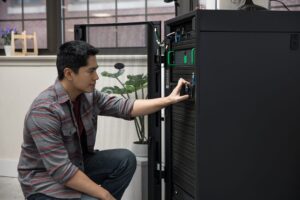Today’s highly connected facilities have created a greater need for IT and OT to work together. In a previous post, I wrote about how these functions are moving from convergence to collaboration, and how this is critical to running security applications.
Furthermore, keeping buildings operational, IT running, and security systems up depends on the availability of the network and server platforms they are running on, and these systems are only as available as the power supporting them. That’s why centralized, remote management and uninterruptible power is imperative.
Power Loss
In these modern environments, even a short-term power loss can result in longer-term system outages and the compromised operation of critical systems like security. Power interruptions are a likely cause of such outages if backup systems are not in place and managed properly.
Such short term events can have a myriad of causes, occur at a subsystem (branch or feeder circuit level) and far more often than an extended utility outage. As an example, hospital environments often provide backup generators for extended outages but not to all systems. This approach does not provide power in the time it takes generators to come on line.
In manufacturing environments, dynamic electrical loads as well as maintenance activities and protective functions can cause many short duration outages. UPS backup can, in these cases, keep systems awake and controlled during the outage or issue.
What happens during this blip? That depends on which intelligent system without uninterrupted power is affected during an outage. In the case of security applications, the questions would be: Which workers got in or out? Did any outsiders breach the building? Is critical data missing from cameras? Could the incident have been intentional? And these are just in regard to access and security; power loss can obviously also disrupt business operations.
Managing Power across IT and OT
Implementing centrally managed and monitored UPS systems that are tied to hardware and software systems that are, in turn, part of a network infrastructure that is an extension of both the IT and OT environments will help ensure uptime.
Critical power for security and other critical facility applications can be monitored by both the building management system (BMS) and data center infrastructure management (DCIM) systems as part of an extended IT/OT converged enterprise.
Working together, IT and OT can guarantee the highest availability of critical systems; OT ensuring the processes supported by the applications and IT supporting the availability of hardware, software and networks supporting those applications. Leveraging both disciplines in conjunction with clean reliable power delivery will provide the appropriate insights.
In this day and age, where many threats are coming in through the network, physical security is playing a much bigger role in cybersecurity. IT must be protected from building to room to rack. It is an ironic but serious truth that physical security applications running on poorly managed and unmonitored IT infrastructure represents a substantial cyber-security threat.
Thus, today’s complex and connected environment has shifted the focus from just having technical convergence for IT/OT to full departmental collaboration. As these lines blur, both sides of the “aisle” will need help through outside expertise. Start by exploring the topic more in our White Paper 233, “Selecting a Building Management System (BMS) for Sites with a Data Center or IT Room.”



